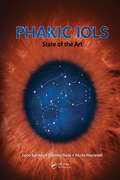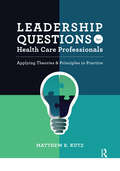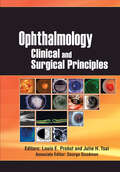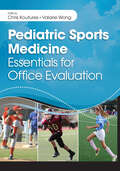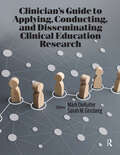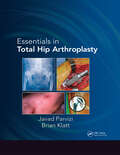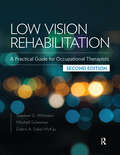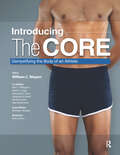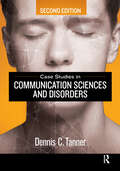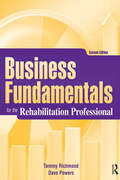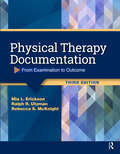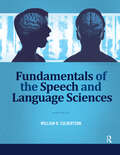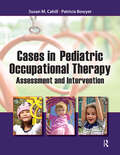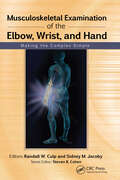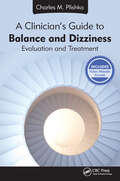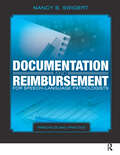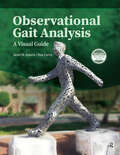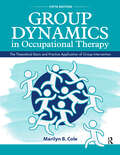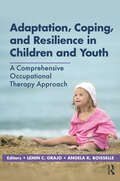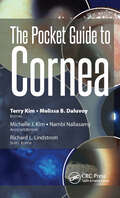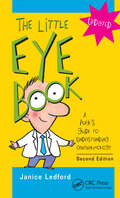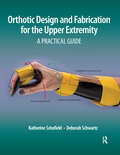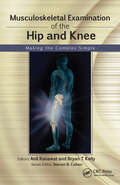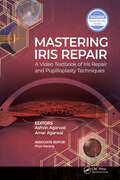- Table View
- List View
Phakic IOLs: State of the Art
by Lucio Buratto Stephen Slade Nicola HauraniehThe surgical correction of refractive vision errors has dramatically and continually changed over time. The evolution of laser vision correction has been aided by advancements in the technology, growing experience, and improved understanding of the eye and its response to surgery. However, not all refractive errors can be treated with the laser. Phakic IOLs: State of the Art is designed to provide the advances in phakic IOL technology and techniques, ideal for physicians who treat many of the patients who are not candidates for laser vision correction. The collaboration of Dr. Lucio Buratto, Dr. Stephen G. Slade, and Dr. Nicola D. Hauranieh, along with a team of international surgeons, has produced a complete book specifically aimed to improve the treatment and therefore the quality of vision of patients. Phakic IOLs: State of the Art is designed for ophthalmologists interested in learning the concepts, developing the skills, and preparing for phakic IOL procedures. This book contains a detailed description of the basic technique of the operations, as well as the special techniques devised by the international contributors. Richly illustrated with over 200 images that demonstrate the various concepts, readers are able to develop a more thorough understanding of phakic IOL implantation. This definitive resource couples both the authors’ and contributors’ diverse experience and knowledge to produce a complete resource of vision correction with phakic IOLs.Expert ophthalmologists interested in being on the cutting edge and enhancing their surgical skills, as well as new physicians, will benefit from adding Phakic IOLs: State of the Art to their personal library.
Leadership Questions for Health Care Professionals: Applying Theories and Principles to Practice
by Matthew KutzLeadership Questions for Health Care Professionals: Applying Theories and Principles to Practice by Dr. Matthew R. Kutz presents some of the most common leadership questions with the intent to facilitate intrigue and dialogue about the general concept of leadership and an awareness of potential leadership issues facing health care professionals.Leadership Questions for Health Care Professionals presents responses that will initiate discussion, as well as offer solutions based on the best available evidence across a wide spectrum of relevant research. Discussion questions at the end of each response will allow the reader to engage in critical thinking and re-evaluate their experiences and offer new insights into their leadership journey.Sections include questions on key issues for health care professionals: The essence of leadership Leadership development Teamwork and communication Change Organizational culture and complexity Leadership ethics and power Diversity and multicultural leadership Leadership Questions for Health Care Professionals takes an interprofessional and interdisciplinary approach and is relevant for athletic trainers, physical therapists, occupational therapists, speech-language pathologists, nurses, physicians, and more.Leadership Questions for Health Care Professionals: Applying Theories and Principles to Practice offers students a broader conceptual understanding of leadership, as well as the depth required by seasoned health care clinicians, managers, and executives who are looking for practical and evidence-based insights to their toughest leadership issues.
Ophthalmology: Clinical and Surgical Principles
by Louis Probst Julie TsaiOphthalmology: Clinical and Surgical Principles is a comprehensive, yet, accessible guide to medical and surgical ophthalmology that succinctly addresses the diagnosis and treatment of all major diseases of the eye. Louis E. Probst, Julie H. Tsai, and George Goodman, along with the 16 world expert subspecialty contributors, have organized the concise, clinically focused, and user-friendly chapters by subspecialty and include the indications, techniques, and complications of common ophthalmic surgical procedures. This attentive chapter organization reflects the way modern-day ophthalmology is practiced.Ophthalmology: Clinical and Surgical Principles delivers practical emphasis, allowing the reader to apply the information into a clinical setting. Residents will additionally benefit from the surgical options discussed for specific disorders. Features:• More than 400 high-quality diagrams, figures, and color photographs.• Diagrams, tables, and figures to facilitate comparisons and assimilation of the information.• References to provide a starting point for further study and research.• Study questions at the conclusion of each chapter to allow readers to test their knowledge and prepare for important examinations.Ophthalmology: Clinical and Surgical Principles is comprehensive and practical enough to be a complete resource for the ophthalmologist, ophthalmology resident, optometrist, as well as family physicians, medical students, and ophthalmic technician.
Pediatric Sports Medicine: Essentials for Office Evaluation
by Chris Koutures Valarie WongPediatric Sports Medicine: Essentials for Office Evaluation is a clinically relevant reference presented in a question-and-answer format designed to be a primary resource for all pediatric providers and health care professionals who work closely with children or young adults with sports related injuries.Dr. Chris Koutures and Dr. Valarie Wong explore the topics most commonly asked pertaining to pediatric sports medicine, in a casual, yet informative manner. The unique format of this cutting-edge book provides a rapid reference and “quick look-up” for today’s busy practitioner.Pediatric Sports Medicine: Essentials for Office Evaluation includes unique chapters such as key sports medical terms and phrases, how to take a sports medicine history, what imaging studies to order, and how to determine safe return to play for many medical and musculoskeletal concerns.Additional features include:• Information on pediatric sports medicine rehabilitation• Tips on specialty referral• Generous use of tables and figures • Pictures of labeled images and radiographs that highlight key landmarks and points of emphasisWith contributions from many of the experts in the field, Pediatric Sports Medicine: Essentials for Office Evaluation is an easy-to-read resource for any medical practitioner, including physicians, nurse practitioners, physician assistants, residents, medical students, physical therapists, and athletic trainers, and many more, seeking to quickly expand their knowledge of pediatric sports medicine.
Clinician’s Guide to Applying, Conducting, and Disseminating Clinical Education Research
by Mark DeRuiter Sarah GinsbergClinician's Guide to Applying, Conducting, and Disseminating Clinical Education Research provides clinical educators with the fundamental knowledge to be effective consumers of research and integrate it into their clinical education practice.Clinical educators are routinely called upon to provide early-career clinicians with clinical education and supervision within their practice. Clinician’s Guide to Applying, Conducting, and Disseminating Clinical Education Research fits at the intersection of clinical education and research for the supervising clinician—helping clinicians consider how they might contribute to the scholarship of teaching and learning related to clinical education.This one-of-a-kind text features a multidisciplinary perspective with contributors from various fields in allied health, such as speech-language pathology, occupational therapy, audiology, physical therapy, and more.What’s included in Clinician’s Guide to Applying, Conducting, and Disseminating Clinical Education Research: A hands-on workbook section for clinical educators to apply the content to education and clinical supervision research Chapters on seeking research mentorship, qualitative and quantitative research foundational concepts, and publishing and presenting research Parallels between evidence-based practice and evidence-based education Clinician’s Guide to Applying, Conducting, and Disseminating Clinical Education Research walks the reader through generating research all the way to implementation and dissemination while linking communities of working professionals to their students and research institutions.
Essentials in Total Hip Arthroplasty
by Javad Parvizi Brian KlattEssentials in Total Hip Arthroplasty by Dr. Javad Parvizi is a succinct, yet comprehensive text that provides a unique and colorful look into the world of total hip arthroplasty, an in-depth history of this common procedure, as well as strategies to treat and prevent complications.Inside you will find information on:• Patient selection• Preoperative templating• Surgical techniques• Relevant anesthesia and pain management• Postoperative rehabilitation• Strategies for minimization of complications• Relevant figures and diagrams• And much moreEssentials in Total Hip Arthroplasty is unique in its format to provide basic and detailed information on total hip arthroplasty from A to Z with descriptive, easy-to-read text and extensive visual elements, such as charts and tables.With total hip arthroplasty being the most successful and popular procedure and each chapter being written by both a resident and an attending, Essentials in Total Hip Arthroplasty will be the essential “go-to” text for residents, fellows, physical therapists, students, and junior attendings involved with all matters related to the procedure.
Low Vision Rehabilitation: A Practical Guide for Occupational Therapists
by Mitchell Scheiman Stephen Whittaker Debra Sokol-McKayThis Second Edition of Low Vision Rehabilitation: A Practical Guide for Occupational Therapists provides current, evidence-based information on low vision rehabilitation that contains several new and expanded chapters on ADLs, IADLs, and recreation, as well as new online resources and the latest in accessibility devices.Low vision rehabilitation is rapidly growing as a specialty practice for occupational therapists. This growth requires practical, evidence-based information on the evaluation and treatment of the effects of low vision on occupational performance. Responding to this need, Low Vision Rehabilitation: A Practical Guide for Occupational Therapists, Second Edition blends standards of practice that have been developed for over 50 years by low vision therapists and optometrists, with the latest scientific research and the unique perspective of occupational therapists.This text is written to introduce the student and general practitioner to low vision rehabilitation as commonly encountered in medical rehabilitation as well as provides a conceptual approach to evaluation and treatment that will enrich an advanced practice. Authors Stephen Whittaker, a low vision researcher, certified low vision therapist and occupational therapist, Mitchell Scheiman, an optometrist and researcher, and Debra Sokol-McKay, an occupational therapist with specialty certification in low vision as well as certification as a low vision therapist, vision rehabilitation therapist and diabetes educator, have carefully selected evidence-based evaluations and treatments that focus on clinical practicality and meaningful occupational goals in adults.New to the Second Edition: A focus on occupational performance using “whatever works,” whether visual, non-visual, or a combination of these different devices and adaptive techniques The “EPIC” Framework, a general strategy to organize a treatment plan for daily activities using visual and non-visual techniques Access to a companion website designed as a handy clinical reference, with solutions to clinical problems easily searchable and cross-linked to related content The “Success-Oriented Approach” to interventions based on the most recent research on cognitive disability and depression associated with low vision Applications of the latest electronic accessibility devices including smartphones, tablets, and magnifiers that read aloud Incorporates the AADE™ 7 Self-Care Behavior framework of the American Association of Diabetes Educators Incorporates concepts from the latest edition of the AOTA Occupational Therapy Practice Framework: Domain and Process A chapter devoted to field loss, spatial neglect and perceptual impairments resulting from acquired-brain-injury. The latest in Medicare documentation standards including outcome to G-code conversions and ICD-10 diagnostic coding for low vision. Included with the text are online supplemental materials for faculty use in the classroom.Features Included: Recommended practical evaluation and treatment methods such as a 1 hour evaluation protocol, how to write observable and measurable goals and document outcomes, and specific instructions on how to implement treatments Prepares therapists for the ACVREP certification as a low vision therapist or vision rehabilitation or AOTA specialty certification in low vision Emphasizes intervention and low vision rehabilitation treatment including: modification of the environment adaptive visual and non-visual techniques selection and use of non-optical assistive devices selection and use of electronic and optical devices and use of computer technology including smartphones and tablets Comprehensive case studies on vision impairment resulting from eye disease to head injury and more Provides valuable in
Introducing the Core: Demystifying the Body of an Athlete
There is no more important area of the body for an athlete than the core, the region of our body from our chest to our knees. The core is our engine, our hub of activity. Strength there makes life easier for shoulders and knees. It produces speed and explosiveness. Endurance and grit.The core is so important. So why has it remained such a medical mystery?This book will explain that.Introducing the Core: Demystifying the Body of an Athlete traces the arc of the journey from injury to restoration of power to the return to normal life.Dr. William Meyers is the nation’s foremost authority on core health. Along with over 40 world-renowned expert contributors, Dr. Meyers explains how the core functions through stories from his work in locker rooms, the operating room, and the playing fields of elite athletes, giving readers a thorough understanding of the core’s widespread influence on athleticism and the human anatomy.The book: Dissects the events that led Dr. Meyers and his team of experts to their new appreciation of this anatomy Brings multiple world-renowned arthroscopists into the overall core picture, providing their perspectives on how the core works, with the pubic bone as “the sun” of the body’s universe Offers insight into the many causes of pelvic pain, demonstrating why the term “sports hernia,” should be banished forever Emphasizes the fact that a wide spectrum of professionals treat the core -- from traditional surgeons to alternative therapists Brings it all together and proposes a new future, and perhaps a new medical specialty, that is the core “Strength, power, and endurance all flow from the core. This book, and the work Bill Meyers has done in the field, will bring good core health to the forefront and help everyone—elite athletes and others.”—Michael William Krzyzewski“Even in baseball, injury patterns in the shoulder and elbow are related to core imbalance. This book has been needed for a long time… Bill has helped the idea of core strength become more popular, and this book could be what is needed to get it more attention.”—James Rheuben Andrews, MD“To understand the core, you must put on new eyes.” —Marshawn Lynch
Case Studies in Communication Sciences and Disorders
by Dennis TannerThe discipline of communication sciences and disorders is an exciting field that appreciates the wonders and complexities of human communication. Case Studies in Communication Sciences and Disorders, Second Edition is an informative and relevant text that addresses the myriad disorders, deficits, diseases, and disabilities that can lay waste to the incredible systems involved in communication.Case Studies in Communication Sciences and Disorders, Second Edition by Dr. Dennis Tanner provides engaging factual and historical information about each of the major communication disorders. The case studies presented in each chapter uncover the functional barriers encountered by clients of practicing speech-language pathologists and audiologists. Each chapter provides a scholarly overview of a communication disorder with an emphasis on etiology, diagnosis, and treatment and uses several case studies to illustrate the many different presentations of each disorder. Over 50 case studies reflect true clinical practice and include detailed patient histories that give humanity and depth to the patient-clinician relationship.Chapter Topics in the Second Edition Include: Language delays and disorders Articulation and phonology disorders Stuttering Voice and resonance disorders Aphasia Motor speech disorders Dysphagia Traumatic brain injury Hearing loss and deafness Case Studies in Communication Sciences and Disorders, Second Edition is a relevant and readable text for speech-language pathology and audiology students and clinicians that takes theory and clinical reasoning and applies them to a variety of interesting cases.
Business Fundamentals for the Rehabilitation Professional
by Tammy Richmond Dave PowersThe world of business is ever changing, with much of the available information becoming quickly out-of-date. Business Fundamentals for the Rehabilitation Professional, Second Edition keeps pace with this changing world and provides the health care professional with the latest information to answer the “what, where, how, and when” questions that come up when transforming a health care practice idea into a successful business.With this updated Second Edition, Tammy Richmond and Dave Powers take the health care professional to the next level of implementing successful business operations by the introduction of applications of management principles, as well as implementation of evidence-based practice guidelines and basics to billing and coding documentation. Business Fundamentals for the Rehabilitation Professional, Second Edition addresses how to identify emerging business opportunities, legal and health care regulatory issues, market research and development, and health care operations.New features in the Second Edition: New Management and Operations checklist An in-depth look at reimbursement, billing, and financial survival Strategic target market promotions Updated templates and tools Review questions Downloadable worksheets available with text purchase Keeping the user-friendly format of a workbook, Business Fundamentals for the Rehabilitation Professional, Second Edition is the perfect resource for master and doctorate level students preparing for the professional world, as well as rehabilitation professionals and entrepreneurs interested in obtaining knowledge in starting up, managing, expanding, or understanding the health care practice system.What will you learn? How to create a vision and mission statement How to develop a business and marketing plan How to manage finances within the scope of the practice What are your local state and federal regulations What are the small business guidelines
Physical Therapy Documentation: From Examination to Outcome
by Mia Erickson Rebecca McKnight Ralph UtzmanNewly updated and revised, Physical Therapy Documentation: From Examination to Outcome, Third Edition provides physical therapy students, educators, and clinicians with essential information on documentation for contemporary physical therapy practice.Complete and accurate documentation is one of the most essential skills for physical therapists. In this text, authors Mia L. Erickson, Rebecca McKnight, and Ralph Utzman teach the knowledge and skills necessary for correct documentation of physical therapy services, provide guidance for readers in their ethical responsibility to quality record-keeping, and deliver the mechanics of note writing in a friendly, approachable tone. Featuring the most up-to-date information on proper documentation and using the International Classification of Functioning, Disabilities, and Health (ICF) model as a foundation for terminology, the Third Edition includes expanded examples across a variety of practice settings as well as new chapters on: Health informatics Electronic medical records Rules governing paper and electronic records Billing, coding, and outcomes measures Included with the text are online supplemental materials for faculty use in the classroom.An invaluable reference in keeping with basic documentation structure, Physical Therapy Documentation: From Examination to Outcome, Third Edition is a necessity for both new and seasoned physical therapy practitioners.
Fundamentals of the Speech and Language Sciences
by William CulbertsonFor a strong foundation upon which to build their futures, students in communication sciences and disorders programs need the best, most up-to-date information available to guide them. To this end, Fundamentals of the Speech and Language Sciences provides a thorough understanding of the core concepts in speech and language while maintaining a readable, engaging tone. Students will be exposed to the fundamentals of acoustics, respiratory science, voice production, acoustic phonetics, and sound spectrography. Language representation and motor programming as they pertain to the dynamic process of speech communication are also explored, as are the fundamentals of speech perception and instrumentation. To give students context, side bars feature the stories of seminal scientists and scholars and their contributions to the topics being discussed. This text benefits from Dr. William Culbertson’s nearly three decades of experience in teaching, as well as another decade of experience as a clinical speech-language pathologist. That experience has honed his ability to clearly communicate these crucial topics in a way that students will understand.Topics covered: The scientific method and various types of research used to study the normal aspects of human speech and hearing The basics of physics as they pertain to energy, motion, displacement, force, and pressure and their relationship to speech production The process of respiration as it pertains to gas compression, speech valving, driving pressure, impedance, and flow Voice onset, modes of vocal vibration, pitch adjustment, volume and quality The process of dynamic interaction representation at the cortical and subcortical levels of the five basic speech processes: respiration, phonation, articulation, resonance, and prosody Undergraduate students in communication sciences and disorders programs, as well as the related programs of music (voice), special education, and speech communication, will value Fundamentals of the Speech and Language Sciences as the formative text for their understanding of the speech and language sciences.
Cases in Pediatric Occupational Therapy: Assessment and Intervention
by Susan Cahill Patricia BowyerCases in Pediatric Occupational Therapy: Assessment and Intervention is designed to provide a comprehensive collection of case studies that reflects the scope of current pediatric occupational therapy practice.Drs. Susan Cahill and Patricia Bowyer, along with more than 50 contributors, begin each section with an introduction to the practice setting and direct instructors and students to additional resources for more information. The text includes more than 40 cases that include client overviews, relevant history and background information; information regarding the analysis of occupational performance; information about progress in treatment; and questions to promote the development and refinement of clinical reasoning skills.Cases are presented from various practice settings, including: The neonatal intensive care unit Early intervention School systems Outpatient services Hospital-based settings Mental health settings Community settings Each case included in Cases in Pediatric Occupational Therapy is written by professionals with first-hand experience working with pediatric clients from the specific practice setting, and it aligns with the occupational therapy process represented in the AOTA’s Occupational Therapy Practice Framework, Third Edition. In addition, supplemental information, photographs, and video clips help to bring the cases to life. Included with the text are online supplemental materials for faculty use in the classroom.Cases in Pediatric Occupational Therapy will guide occupational therapy students, faculty, and practitioners through effective clinical decision making during the selection of assessment procedures and the development of client-centered and context-specific intervention plans.
Musculoskeletal Examination of the Elbow, Wrist, and Hand: Making the Complex Simple
by Randall Culp Sidney JacobyThe physical examination of the elbow, wrist, and hand can be a complex topic for professionals with all levels of clinical experience. How can advance concepts be taught in a user friendly, clear format, while still providing necessary information for effective diagnosis and treatment of the elbow, wrist, and hand?Musculoskeletal Examination of the Elbow, Wrist and Hand: Making the Complex Simple by Dr. Randall Culp answers these questions. Written by experts, this easy-to-carry book provides a thorough review of the most common pathologic elbow, wrist, and hand conditions, techniques for diagnosis, as well as the appropriate treatment for each condition.Musculoskeletal Examination of the Elbow, Wrist and Hand: Making the Complex Simple contains clear photographic demonstrations, tables, sidebars, and charts throughout its pages, allowing a thorough and concise examination of the elbow, wrist, and hand.A glance at what is covered inside: Physical Examination Basics and specific tests of the elbow, wrist, and hand General Imaging Basics of general imaging of the elbow, wrist, and hand Common Conditions Tendinopathy, arthritis, wounds, soft tissue injuries, and more Musculoskeletal Examination of the Elbow, Wrist and Hand: Making the Complex Simple contains essential information to successfully take a complex subject, and bring it to a level that will be welcomed by all orthopedic residents, attendings, physical therapists, athletic trainers, medical students in training, and other health care providers.
A Clinician's Guide to Balance and Dizziness: Evaluation and Treatment
by Charles M. PlishkaWith an increasing number of referrals to treat balance impairment, gait disorders, and dizziness, A Clinician’s Guide to Balance and Dizziness: Evaluation and Treatment by Dr. Charles M. Plishka looks to address these issues and provides tests, measures, and interventions that are matched to research studies when available, for evidence-based practice. It begins with a review of the anatomy and physiology of the systems used to balance. With a basic understanding of how we balance, the signs and symptoms of patients will be understood with much greater ease.A Clinician’s Guide to Balance and Dizziness enables the reader to perform a complete and thorough evaluation and helps to provide treatment options for identified deficits that place the patient at risk for falls. Along with numerous diagrams and photos, this text comes with access to a web site containing video clips that demonstrate key evaluation and treatment techniques. The result will be a better evaluation, treatment plan, and outcome.Topics and Features Include: How do we balance? Tests to evaluate the balance-impaired patient Tests and interventions for conditions such as Benign Paroxysmal Positional Vertigo (BPPV), Vestibular Loss, and the central and peripheral causes of dizziness Therapy treatments “How to” instructions throughout Companion web site with video clips demonstrating evaluation and treatments A Clinician’s Guide to Balance and Dizziness: Evaluation and Treatment is an easy-to-use reference perfect for professionals who assess and treat balance impairments and dizziness. While it is an instructional text for physical therapy students and clinicians, it is also a great reference for established physicians, vestibular and balance therapy specialists, occupational therapists, nurse practitioners, physician assistants, audiologists, and athletic trainers.
Documentation and Reimbursement for Speech-Language Pathologists: Principles and Practice
by Nancy SwigertAlthough it is the least noticed by patients, effective documentation is one of the most critical skills that speech-language pathologists must learn. With that in mind, Documentation and Reimbursement for Speech-Language Pathologists: Principles and Practiceprovides a comprehensive guide to documentation, coding, and reimbursement across all work settings.The text begins with section 1 covering the importance of documentation and the basic rules, both ethical and legal, followed by an exploration of the various documentation forms and formats. Also included are tips on how to use electronic health records, as well as different coding systems for diagnosis and for procedures, with an emphasis on the link between coding, reimbursement, and the documentation to support reimbursement.Section 2 explains the importance of focusing on function in patient-centered care with the ICF as the conceptual model, then goes on to cover each of the types of services speech-language pathologists provide: evaluation, treatment planning, therapy, and discharge planning. Multiple examples of forms and formats are given for each.In section 3, Nancy Swigert and her expert team of contributors dedicate each chapter to a work setting in which speech-language pathologists might work, whether adult or pediatric, because each setting has its own set of documentation and reimbursement challenges. And since client documentation is not the only kind of writing done by speech-language pathologists, a separate chapter on “other professional writing” includes information on how to write correspondence, avoid common mistakes, and even prepare effective PowerPoint presentations.Each chapter in Documentation and Reimbursement for Speech-Language Pathologists contains activities to apply information learned in that chapter as well as review questions for students to test their knowledge. Customizable samples of many types of forms and reports are also available.Included with the text are online supplemental materials for faculty use in the classroom.Documentation and Reimbursement for Speech-Language Pathologists: Principles and Practice is the perfect text for speech-language pathology students to learn these vital skills, but it will also provide clinical supervisors, new clinicians, and speech-language pathologists starting a private practice or managing a department with essential information about documentation, coding, and reimbursement.
Observational Gait Analysis: A Visual Guide
by Janet Adams Kay CernyObservational Gait Analysis: A Visual Guide is a pedagogical manual and video library that provides a thorough review of key characteristics of normal gait that are important for observational clinical gait analysis.This visual guide by Drs. Jan Adams and Kay Cerny has unique features to further the understanding of examination and evaluation of the subject’s gait, such as: Normal and pathological gait are described using figures and graphs, along with gait videos and 3D graphs to show the kinematics and kinetics described Functional tools used as outcome measures to evaluate gait performance in the community environment including Dynamic Gait Test, Six Minute Walk Test, Ten Meter Walk Test, to name a few In addition to the unique features, the pathological gait section presents descriptions of gait deviations included in a new clinical Observational Gait Analysis (OGA) tool, along with probable causes for each of the deviations. Case studies are presented using this new tool for examining and evaluating the subject’s gait. Bonus!Students will be able to watch antero-posterior and lateral videos of individuals with gait deviations, complete the OGA tool to document their gait examination, and evaluate their examination results. They will then validate their observational skills by comparing their results to the text’s case study OGA results and the skeletal model and motion and moment graphs completed by 3D instrumented analysis of the same individual. The student will then compare their evaluation of causes of deviations to that included in the case study. Included with the text are online supplemental materials for faculty use in the classroom.Observational Gait Analysis: A Visual Guide will be the go-to resource for clinical tools to analyze gait for physical therapy and prosthetic and orthotic students and clinicians, as well as other professionals interested in the clinical analysis of persons with gait disability.
Group Dynamics in Occupational Therapy: The Theoretical Basis and Practice Application of Group Intervention
by Marilyn B. ColeIn occupational therapy practice, well designed groups represent social and cultural contexts for occupational performance in everyday life. Group Dynamics in Occupational Therapy: The Theoretical Basis and Practice Application of Group Intervention, the best-selling text for over 25 years by Marilyn B. Cole, has been updated to a Fifth Edition, offering strategies and learning tools to place clients in effective groups for enhanced therapeutic interventions. Updated to meet the AOTA’s Occupational Therapy Practice Framework, Third Edition, this Fifth Edition provides guidelines for occupational therapy group design and leadership and guides application of theory-based groups. The theory section clarifies how occupation based models and frames of reference change the way occupational therapy groups are organized and how theory impacts the selection of group activities, goals, and outcomes. Recent examples and evidence are added in this Fifth Edition to reflect the design and use of groups for evaluation and intervention within the newly evolving paradigm of occupational therapy. The third section focuses on the design of group protocols and outlines a series of group experiences for students. These are intended to provide both personal and professional growth, as well as a format for practice in group leadership, self-reflection, cultural competence, and community service learning. A new chapter focusing on the recovery model and trauma-informed care suggests ways for occupational therapists to design group interventions within these broadly defined approaches. Cole’s 7-step format for occupational therapy group leadership provides a concrete, user-friendly learning experience for students to design and lead theory based groups. The settings for which students can design group interventions has been updated to include current and emerging practice settings. Included with the text are online supplemental materials for faculty use in the classroom. With a client-centered theoretical approach, Group Dynamics in Occupational Therapy: The Theoretical Basis and Practice Application of Group Intervention, Fifth Edition continues a 25-year tradition of education for occupational therapy and occupational therapy assistant students and clinicians.
Adaptation, Coping, and Resilience in Children and Youth: A Comprehensive Occupational Therapy Approach
by Lenin Grajo Angela BoisselleA groundbreaking text for occupational therapists, Adaptation, Coping, and Resilience in Children and Youth: A Comprehensive Occupational Therapy Approach offers a different perspective in addressing the ways children and youth with a variety of conditions and personal contexts can have more optimized participation in everyday life. This text is essential for occupational therapy graduate students, instructors, and pediatric clinicians.Drs. Lenin C. Grajo and Angela K. Boisselle provide a comprehensive, strength-based approach in addressing the ability of children to adjust to a variety of challenges encountered in daily life across multiple environments and contexts. Adaptation, Coping, and Resilience in Children and Youth includes best and evidence-based practices for assessment and intervention.Included in the book: Collaborative approach with families How to build relationships through interprofessional collaboration (teachers, health care team, and community) Global perspectives of adaptation, coping, and resilience Case applications and essential considerations for occupational therapists The text also covers underexplored contexts such as those who have been bullied, children and youth who are LGBTQ and gender expansive, children and youth of color, those who live as a member of a migrant family, and those who have lived with and through adverse childhood experiences.Adaptation, Coping, and Resilience in Children and Youth: A Comprehensive Occupational Therapy Approach is a necessary text that offers timely best and evidence-based practices for assessment and intervention for occupational therapy students and professionals.
The Pocket Guide to Cornea (Pocket Guides)
by Terry Kim Melissa DaluvoyAre you a medical student or resident trying to absorb as much information on the cornea as efficiently as possible? Are you an ophthalmologist who needs fast facts on a specific corneal disease? Reach into your lab coat pocket and pull out The Pocket Guide to Cornea for easy access to the information you need right now. Drs. Terry Kim and Melissa Daluvoy have designed this book as the most effective way to take in the information on the cornea for the entire spectrum of eye care providers. Medical students and residents will be pleased to have this accessible, high-yield handbook during their rotations to familiarize themselves with cornea findings and diagnoses, while seasoned ophthalmologists will be glad to have it as a refresher or quick reference guide to current diagnostic and treatment standards. Contained within The Pocket Guide to Cornea is the most essential information on the cornea organized in the most efficient ways. Each chapter is arranged in bullet-point style, for quick access to the relevant information, and is accompanied by numerous color photographs to help with recognition and retention.Topics covered: Basic examination techniques Anterior segment testing and imaging Common to rare cornea diseases Common procedures and surgeries The entire spectrum of eye care providers can benefit from the high-yield, quick-access information contained within The Pocket Guide to Cornea, whether they are learning about the cornea for the first time or they just need a quick refresher on an obscure corneal disease.
The Little Eye Book: A Pupil's Guide to Understanding Ophthalmology
by Janice K. LedfordThe Little Eye Book: A Pupil’s Guide to Understanding Ophthalmology is an easy-to-understand introduction to the field of eye care that has been updated into a new Second Edition. This book is written with the non-physician in mind, so you won’t be bogged down with heavy details, yet every basic fact that you need is right here. With photographs as well as drawings and helpful tables and charts, this conversational-style text packs a big punch. Beginning with an illustrated description of ocular anatomy, the book sweeps you into the workings of vision with hardly a blink, where you’ll learn what happens when light meets the eye. But life is never perfect, and sometimes the eye isn’t either. You’ll get a good overview of disorders and trauma, from lids to optic nerves. The all-important red eye has a section all its own, including symptoms, signs, what’s an emergency and what’s not. A chapter on eye symptoms and their potential causes will help you understand patients’ complaints.New to the Second Edition: A chapter on refractive errors and their correction, including a section on glasses and contact lenses New technology topics including optical coherence tomography, scanning laser tomography, wavefront analysis and more Updated information on medications and refractive surgery Includes over 65 figures and 10 tables Now you will finally understand how the eye works without spending hours trying to get through an overwhelming medical book. Need to know how to take a history, check vision or pupils, or give someone eye medications? It’s in here! Wonder what special testing is available? We tell you! Have questions about surgery or medical treatment? Yep, we covered that, too, and more! Written by Janice K. Ledford, an eyecare professional with over 26 years of experience, The Little Eye Book: A Pupil’s Guide to Understanding Ophthalmology, Second Edition is perfect for anyone who works in the eye care industry or with patients, but isn’t an ophthalmologist.
Orthotic Design and Fabrication for the Upper Extremity: A Practical Guide
by Katherine Schofield Deborah SchwartzOrthotic Design and Fabrication for the Upper Extremity: A Practical Guide by Drs. Katherine Schofield and Deborah Schwartz is a unique guide that illustrates orthotic design and fabrication in a clear step-by-step fashion by presenting printed textual material along with instructional videos. The first chapters lay the foundation for orthotic design and detail the anatomical knowledge and background information that is required before molding orthoses on clients. Each chapter explores a specific part of the upper extremity, describes several common clinical diagnoses, and highlights typical orthoses that might be utilized to immobilize and protect it. Together, these chapters communicate core, foundational knowledge for the use of orthoses as an intervention in occupational therapy practice. The instructional videos also emphasize the application of biomechanical, anatomic, and clinical constructs in orthotic design, fabrication, and evaluation. The textbook and video content work together enabling students and entry-level practitioners to learn with visual and versatile resources. University faculty members will gain access to ample activities and exercises to augment their classroom and laboratory teaching. This allows for more efficient use of time and appeals to the learning styles of current and future students. This text includes: Chapters devoted to specific type of orthosis for parts of the upper extremity linked to step -by -step instructional videos Case studies to promote a grasp of the knowledge and application to the development of clinical reasoning skills Multiple choice and short answer review questions and activities for most chapters Presentation of current evidence to support the use of the specific orthoses in clinical practice Patterns that can be replicated and check out sheets to critique each orthosis The combination of text materials and instructional video material makes Orthotic Design and Fabrication for the Upper Extremity: A Practical Guide a uniquely valuable resource for occupational therapy students, new graduates, and novice clinicians.
Musculoskeletal Examination of the Hip and Knee: Making the Complex Simple
by Bryan Kelly Anil RanawatThe physical examination of the hip and knee can be a complex topic for professionals with all levels of clinical experience. How can advance concepts be taught in a user-friendly, clear format, while still providing necessary information for effective diagnosis and treatment of the hip and knee?Musculoskeletal Examination of the Hip and Knee: Making the Complex Simple by Drs. Anil Ranawat and Bryan T. Kelly answers these questions. Written by experts, this easy-to-carry book provides a thorough review of the most common pathologic hip and knee conditions, techniques for diagnosis, as well as the appropriate treatment for each condition.Musculoskeletal Examination of the Hip and Knee: Making the Complex Simple contains clear photographic demonstrations, tables, and charts throughout its pages, allowing a thorough and concise examination of the hip and knee.A glance at some of what is covered inside: Physical Examination Basics and specific tests of the physical examination of the hip and knee General Imaging Basics of general imaging of the hip and knee Common Conditions Arthroscopic management of labral tears, snapping hip syndromes, meniscal tears, and more Musculoskeletal Examination of the Hip and Knee: Making the Complex Simple contains essential information to successfully take a complex subject and bring it to a level that will be welcomed by orthopedic residents, attendings, physical therapists, athletic trainers, medical students in training, and other health care providers.
Mastering Iris Repair: A Video Textbook of Iris Repair and Pupilloplasty Techniques
by Ashvin Agarwal Amar AgarwalThe first of its kind on this topic, Mastering Iris Repair: A Video Textbook of Iris Repair and Pupilloplasty Techniques combines practical explanations with dynamic surgical videos and animations, perfect for specialists as well as general ophthalmologists.Together with top surgical experts, Drs. Ashvin Agarwal, Amar Agarwal, and Priya Narang have created an accessible text filled with high-yield information that provides essential coverage of the most recent innovations in iris repair. With appeal for subspecialty areas such as cornea, glaucoma, cataract, and retina, this book identifies abnormalities that are regular challenges for the ocular surgeon. Nearly 200 figures are accompanied by more than 4 hours of new, original instructional video and animation with narration hosted on a companion website.Mastering Iris Repair is divided into 3 sections to provide quick access in a comprehensive resource: Iris repair techniques: Single-pass four-throw pupilloplasty, McCannel and Siepser suturing techniques, different types of sutures, and repair management Special topics: Pinhole pupilloplasty, pupilloplasty in special indications, iris prosthesis, and complications of iris repair and pupilloplasty Extended implications of iris and pupil repair: Iris cosmetics devices, how devices manipulate iris tissue, and intraocular lenses affected by iris repair techniques Abundantly referenced and supplemented by evidence-based cases, Mastering Iris Repair: A Video Textbook of Iris Repair and Pupilloplasty Techniques enhances surgical potential for all ophthalmologists.
Group Dynamics in Occupational Therapy: The Theoretical Basis and Practice Application of Group Intervention
by Marilyn B. ColeIn occupational therapy practice, well designed groups represent social and cultural contexts for occupational performance in everyday life. Group Dynamics in Occupational Therapy: The Theoretical Basis and Practice Application of Group Intervention, the best-selling text for over 25 years by Marilyn B. Cole, has been updated to a Fifth Edition, offering strategies and learning tools to place clients in effective groups for enhanced therapeutic interventions. Updated to meet the AOTA’s Occupational Therapy Practice Framework, Third Edition, this Fifth Edition provides guidelines for occupational therapy group design and leadership and guides application of theory-based groups. The theory section clarifies how occupation based models and frames of reference change the way occupational therapy groups are organized and how theory impacts the selection of group activities, goals, and outcomes. Recent examples and evidence are added in this Fifth Edition to reflect the design and use of groups for evaluation and intervention within the newly evolving paradigm of occupational therapy. The third section focuses on the design of group protocols and outlines a series of group experiences for students. These are intended to provide both personal and professional growth, as well as a format for practice in group leadership, self-reflection, cultural competence, and community service learning. A new chapter focusing on the recovery model and trauma-informed care suggests ways for occupational therapists to design group interventions within these broadly defined approaches. Cole’s 7-step format for occupational therapy group leadership provides a concrete, user-friendly learning experience for students to design and lead theory based groups. The settings for which students can design group interventions has been updated to include current and emerging practice settings. Included with the text are online supplemental materials for faculty use in the classroom. With a client-centered theoretical approach, Group Dynamics in Occupational Therapy: The Theoretical Basis and Practice Application of Group Intervention, Fifth Edition continues a 25-year tradition of education for occupational therapy and occupational therapy assistant students and clinicians.
